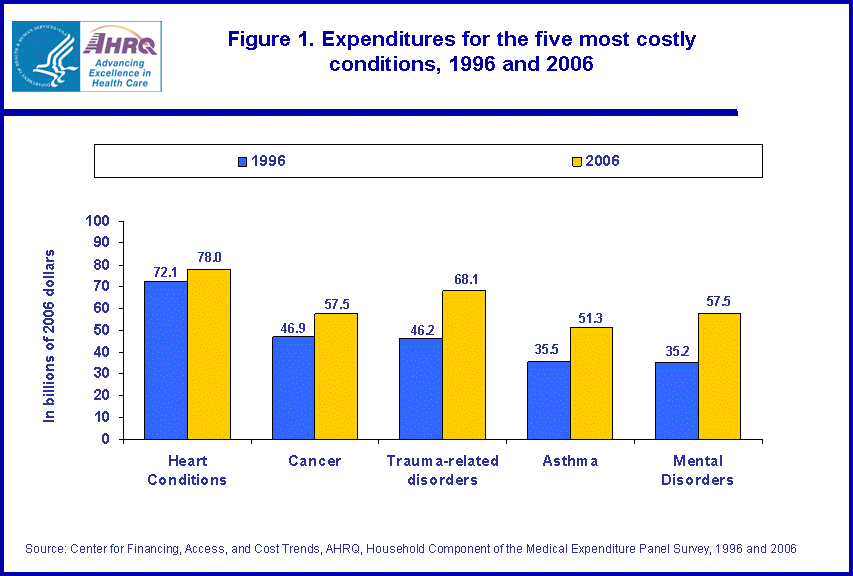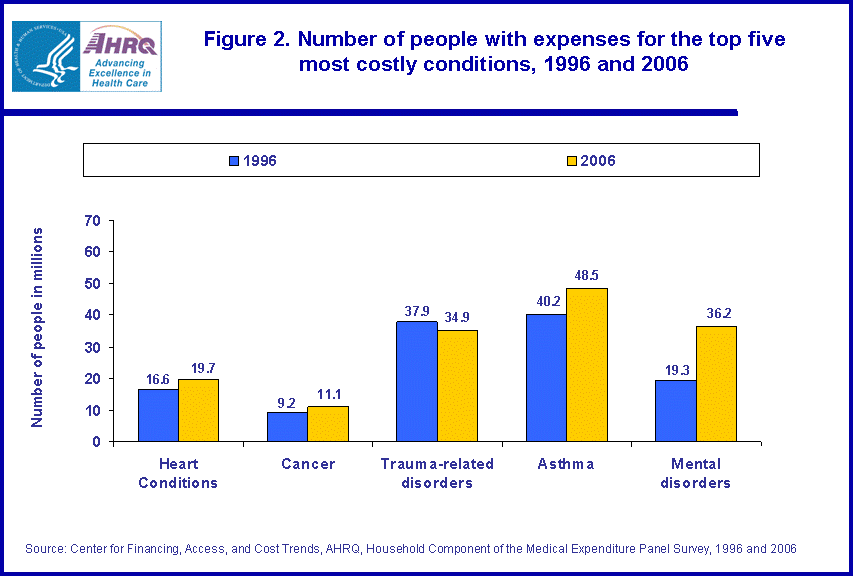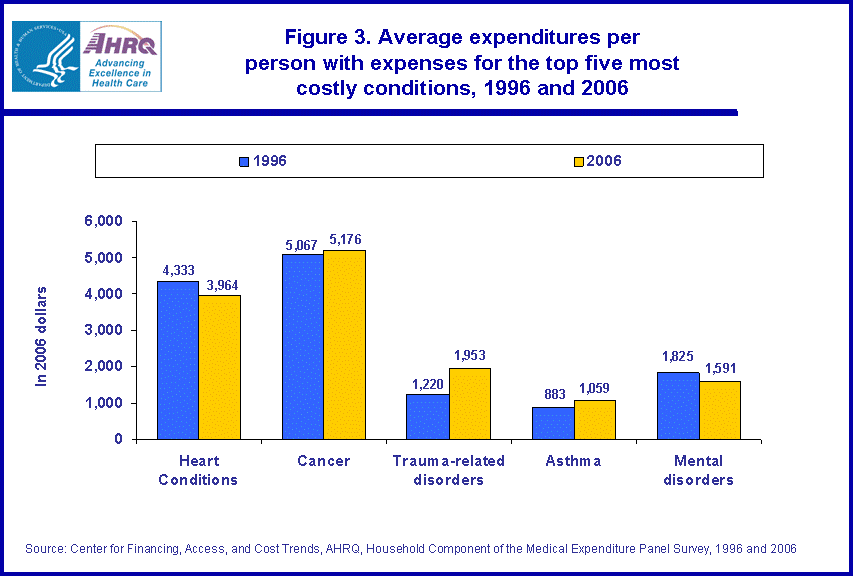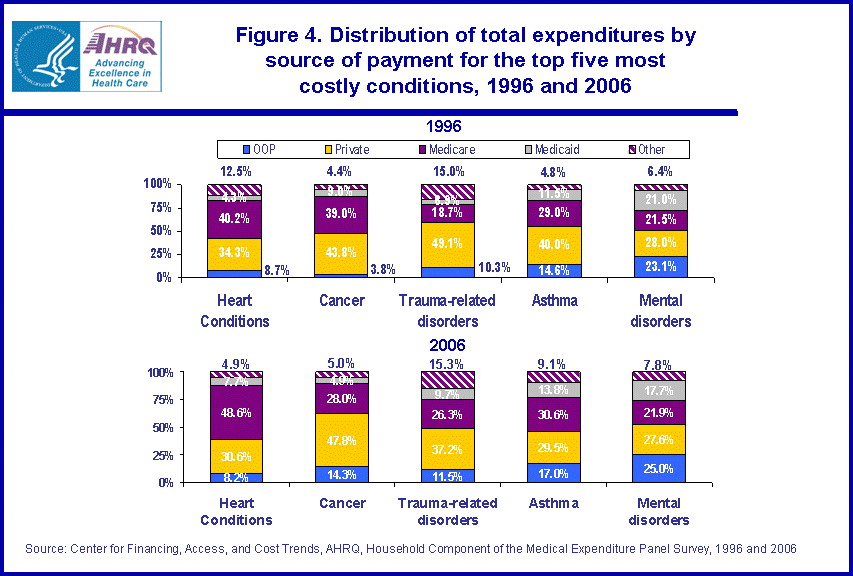
|
|
Font Size:
|
||||
|
|
|
|
||||
STATISTICAL BRIEF #248:
The Five Most Costly Conditions, 1996 and 2006: Estimates for the U.S. Civilian Noninstitutionalized Population
Highlights
- These five medical conditions--heart conditions, cancer, trauma-related disorders, mental disorders, and asthma--ranked highest in terms of direct medical spending in 1996 and 2006.
- The relative increase in medical expenditures was highest for mental disorders and trauma-related disorders between 1996 and 2006.
- The number of people accounting for expenses for mental disorders almost doubled from 19.3 million to 36.2 million.
- Among these five medical conditions, mean expenditures per person were highest for cancer and heart disease for both 1996 and 2006.
Introduction
Previous research has shown that medical expenditures tend to be concentrated on the treatment of specific chronic conditions. The Household Component of the Medical Expenditure Panel Survey (MEPS-HC) provides critical information on trends in health care expenditures for specific conditions. This Statistical Brief presents data from MEPS-HC regarding medical expenditures associated with the top five costly conditions in 1996 and 2006. The top five conditions--heart conditions, cancer, trauma-related disorders, mental disorders, and asthma were determined by totaling and ranking the expenses for the medical care delivered for the diagnosis and treatment of acute and chronic conditions. Only differences between estimates that are statistically significant at the 0.05 level are discussed in the text. Dollar values are adjusted for inflation between the two years using the gross domestic product (GDP) implicit price deflator.Findings
In terms of health care expenditures, the same five conditions were ranked as the five most costly conditions in 1996 and 2006. There was an increase in the expenditures for each of these conditions when comparing them over time. The five most costly conditions were: heart disease, trauma-related disorders, cancer, asthma, and mental disorders. During this period, the largest increase in expenditures was for mental disorders and trauma-related disorders. The expenditures for mental disorders rose from $35.2 billion in 1996 (in 2006 dollars) to 57.5 billion in 2006. Medical expenditures on trauma-related disorders also increased substantially from 1996 (in 2006 dollars) to 2006, $46.2 billion to $68.1 billion (figure 1).The number of people with expenditures associated with these conditions increased from 1996 to 2006 for all conditions except trauma-related disorders. The biggest increase in number of people accounting for expenditures was for mental disorders (19.3 million to 36.2 million) (figure 2).
In terms of mean expenditures per person with expenses, the mean expenditures were highest for cancer ($5,067 and $5,176 respectively) and heart disease ($4,333 and $3,964 respectively) in both years. Asthma had the lowest mean expenditures per person in both 1996 and 2006 ($883 and $1,059 respectively) among the top five most costly conditions (figure 3).
In 1996, out-of-pocket (OOP) expenses were lowest for cancer treatment at 3.8 percent among the top five conditions. In 2006, Medicare paid the largest percentage of heart conditions expenses (48.6 percent) (figure 4). Of these five conditions, out-of-pocket payments were highest for the treatment of mental disorders in both 1996 and 2006 (23.1 percent and 25.0 percent, respectively).
Data Source
The estimates in this Brief for 1996 were derived from MEPS 1996 Full Year Data File (HC-012), and Medical Conditions File (HC-006R). For 2006, the estimates were drawn from Full Year Data File (HC-105) and Medical Conditions File (HC-104).Definitions
**All references to asthma in this Statistical Brief include chronic obstructive pulmonary disorder.Medical conditions
Condition data were collected from household respondents during each round as verbatim text and coded by professional coders using the International Classification of Diseases, Ninth Revision (ICD-9). ICD-9-CM condition codes were then aggregated into clinically meaningful categories that group similar conditions using the Clinical Classification System (CCS) software. Categories were collapsed when appropriate. Note that the reported ICD-9-CM condition code values were mapped to the appropriate clinical classification category prior to being collapsed to 3-digit ICD-9-CM condition codes. The result is that every record which has an ICD-9-CM diagnosis code also has a clinical classification code. For this Statistical Brief, the following CCS codes were used: cancer, 11-45; heart conditions: 96, 97, 100-108; pulmonary conditions (COPD, asthma) 127-134; trauma, 225-236, 239, 240, 244; and mental disorders, 650-663. Even though the mental disorders coding system was somewhat different for 1996, all codes which are part of mental disorders in 2006 were also used in calculations for 1996 mental disorders.
Expenditures
Expenditures refer to what is paid for health care services. More specifically, expenditures in MEPS are defined as the sum of direct payments for care provided during the year, including out-of-pocket payments and payments by private insurance, Medicaid, Medicare, and other sources. Payments for over-the-counter drugs are not included in MEPS total expenditures. Indirect payments not related to specific medical events, such as Medicaid Disproportionate Share and Medicare Direct Graduate Medical Education subsidies, are also excluded.
Expenditures may be associated with more than one condition and are not unduplicated in the condition totals; summing over conditions would double-count some expenses. Total spending does not include amounts for other medical expenses, such as durable and nondurable supplies, medical equipment, eyeglasses, ambulance services, and dental expenses, because these items could not be linked to specific conditions.
About MEPS-HC
MEPS-HC is a nationally representative longitudinal survey that collects detailed information on health care utilization and expenditures, health insurance, and health status, as well as a wide variety of social, demographic, and economic characteristics for the U.S. civilian noninstitutionalized population. It is cosponsored by the Agency for Healthcare Research and Quality and the National Center for Health Statistics.References
For a detailed description of the MEPS-HC survey design, sample design, and methods used to minimize sources on non-sampling errors, see the following publications:Cohen, J. Design and Methods of the Medical Expenditure Panel Survey Household Component. MEPS Methodology Report No. 1. AHCPR Pub. No. 97-0026. Rockville, MD: Agency for Health Care Policy and Research, 1997. http://www.meps.ahrq.gov/mepsweb/data_files/publications/mr1/mr1.shtml
Cohen, S. Sample Design of the 1996 Medical Expenditure Panel Survey Household Component. MEPS Methodology Report No. 2. AHCPR Pub. No. 97-0027. Rockville, MD: Agency for Health Care Policy and Research, 1997. http://www.meps.ahrq.gov/mepsweb/data_files/publications/mr2/mr2.shtml
Cohen, S. Design Strategies and Innovations in the Medical Expenditure Panel Survey. Medical Care, July 2003: 41(7) Supplement: III-5-III-12.
Cohen, J. and Krauss, N. Spending and Service Use among People with the Fifteen Most Costly Medical Conditions, 1997. Health Affairs; 22(2):129-138, 2003.
Suggested Citation
Soni, Anita. The Five Most Costly Conditions, 1996 and 2006: Estimates for the U.S. Civilian Noninstitutionalized Population. Statistical Brief #248. July 2009. Agency for Healthcare Research and Quality, Rockville, MD. http://www.meps.ahrq.gov/mepsweb/data_files/publications/st248/stat248.shtmlAHRQ welcomes questions and comments from readers of this publication who are interested in obtaining more information about access, cost, use, financing, and quality of health care in the United States. We also invite you to tell us how you are using this Statistical Brief and other MEPS data and tools and to share suggestions on how MEPS products might be enhanced to further meet your needs. Please e-mail us at MEPSPD@ahrq.gov or send a letter to the address below:
Steven B. Cohen, PhD, Director
Center for Financing, Access, and Cost Trends
Agency for Healthcare Research and Quality
540 Gaither Road
Rockville, MD 20850
 |
||||||||||||||||||||||||||||||||||||||||||||||||||||||||||||||||||||||||
Source: Center for Financing, Access, and Cost Trends, AHRQ, Household Component of the Medical Expenditure Panel Survey, 1996 and 2006 |
||||||||||||||||||||||||||||||||||||||||||||||||||||||||||||||||||||||||
|
|
||||||||||||||||||||||||||||||||||||||||||||||||||||||||||||||||||||||||
 |
||||||||||||||||||||||||||||||||||||||||||||||||||||||||||||||||||||||||
Source: Center for Financing, Access, and Cost Trends, AHRQ, Household Component of the Medical Expenditure Panel Survey, 1996 and 2006 | ||||||||||||||||||||||||||||||||||||||||||||||||||||||||||||||||||||||||
|
|
||||||||||||||||||||||||||||||||||||||||||||||||||||||||||||||||||||||||
 |
||||||||||||||||||||||||||||||||||||||||||||||||||||||||||||||||||||||||
Source: Center for Financing, Access, and Cost Trends, AHRQ, Household Component of the Medical Expenditure Panel Survey, 1996 and 2006 | ||||||||||||||||||||||||||||||||||||||||||||||||||||||||||||||||||||||||
|
|
||||||||||||||||||||||||||||||||||||||||||||||||||||||||||||||||||||||||
 |
||||||||||||||||||||||||||||||||||||||||||||||||||||||||||||||||||||||||
Source: Center for Financing, Access, and Cost Trends, AHRQ, Household Component of the Medical Expenditure Panel Survey, 1996 and 2006
Source: Center for Financing, Access, and Cost Trends, AHRQ, Household Component of the Medical Expenditure Panel Survey, 1996 and 2006 | ||||||||||||||||||||||||||||||||||||||||||||||||||||||||||||||||||||||||
|
|


